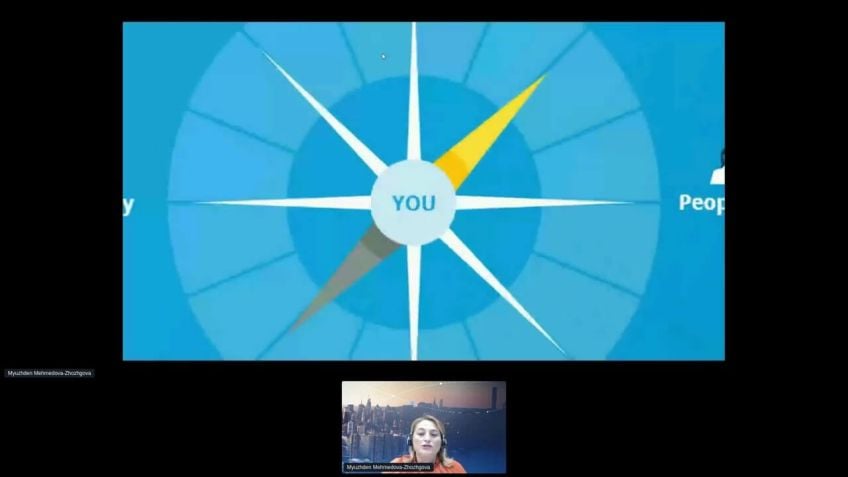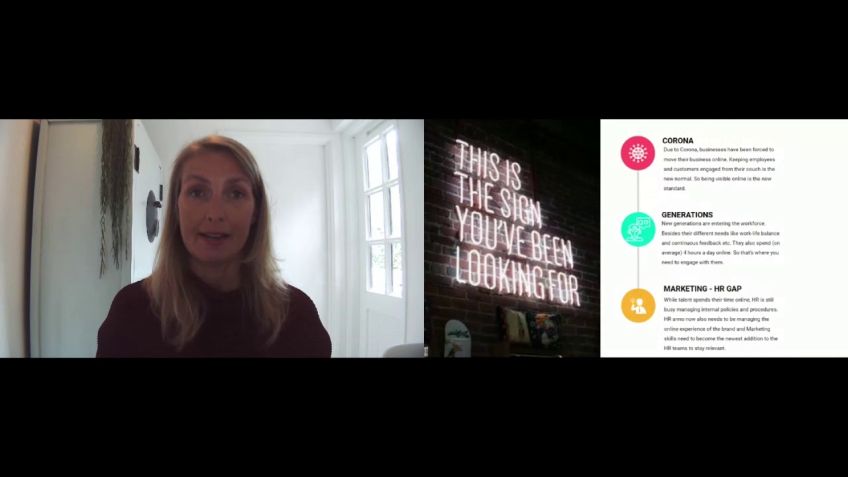Connecting UX and EX is a better experience for everyone
Kelly Jura
VP, Brand and User ExperienceUnderstanding Experience Management: A Holistic Approach
Hello everyone, thank you for joining us today. We would like to give a warm welcome to the Women Tech Network for organizing this fantastic event. I am here today to share important insights into the relevance of a holistic approach to experience management. We'll specifically focus on how focusing on employee experience results in a better experience for end-users, i.e. your customers.
Understanding Screen pal and its Engagement in Experience Management
I am Kelly Jura, the Vice President of Brand and User Experience for Screen pal. Our vision at Screen pal is to create tools that allow people to create, edit, and engage with videos conveniently. Our global user base utilizes these tools for various functions such as learning, training, and development, employee knowledge sharing, and coaching.
The Role of Employee Experience in Business Growth
When businesses think about the employee experience, they typically aim at solving an immediate problem. They often overlook that the experience happens outside of these major events. In both user and employee experience, the multitude of touchpoints make up the experience—providing ample opportunities to either fail, meet, or exceed user expectations.
- Businesses need to understand time sinks, outdated processes, and inconsistencies that are causing friction in the employee experience.
- Companies need to think about minor daily interactions along with the traditional big disruptions.
- Unlike the common misconception, feedback occurs outside the exit interview, contributing to a more holistic understanding of employee experience.
Merging Employee Experience with User Experience
Closing the gap between those responsible for the employee experience and the user experience team empowers companies to deliver better, more engaging experiences. This collaboration shifts the perspective from problem-solving to one of engagement. The User Experience team, with its suite of tools and research methods, can make iterative improvements to the experience.
Is Employee Satisfaction Necessary for Business Growth?
According to Mercer's Global Trends 2022-2023 study titled "The Rise of Relatable Organizations", the percentage of employees feeling energized at work dropped from 74% in 2019 to 63% in 2022. Meanwhile, the risk of burnout increased from 63% in 2019 to 81% in 2022. The pandemic has greatly influenced these shifts. Hence, as much as we depend on employees for business growth, we must ensure that their experience at work is enriching and motivating.
Empathetic Leadership and Employee Experience
Leadership plays a crucial role in shaping the employee experience. According to Deloitte, there is a significant discrepancy between what employees think about their mental and financial wellbeing and what executives perceive of the same. This underlines the need for research that presents a comprehensive picture of the dynamic employee experience.
Improving Employee Experience for Organizational Growth
Rethinking employee experience is pivotal for business growth and delivering on your brand promise. As Kevin Oakes, the author of "The Culture Renovation, a Blueprint for Action", puts it, healthy culture drives great market performance. Satisfied employees are more likely to deliver more and raise the bar for themselves and others around them.
With better employee experience through UX research and design, companies can gather meaningful data that informs ongoing iterative improvements to the working experience.
Conclusion
Understanding and improving employee experience doesn't just lead to happier, more engaged workers. It translates into better customer experiences, improved company performance, and higher quality products and services. In essence, investing time and resources into comprehensive experience management is a worthwhile endeavor for any business.
Thank you for joining me today. We hope you found this discussion insightful. For further resources, check out 'Culture Renovation' by Kevin Oakes and 'I Hate it Here' by Heba Yousef. Feel free to connect with me via email or LinkedIn for any additional questions or insights. Stay engaged, stay connected!
Video Transcription
Welcome and thank you to the Women Tech Network for putting on this great event.And thank you for joining me today as I talk about how a holistic approach to experience management, including a focus on employee experience or ex results in a better experience for everyone, including your end users or customers. I am Kelly Jura. I'm the vice president of brand and user experience for screen pal. We create tools for everyone to create, edit and engage with videos. Our global user base creates videos for learning, training and development, employee knowledge sharing and coaching. And if screen pal looks new to you, that's because we've recently rebranded. We used to be called screencast Matic, but after about five years of research and very hard work, um we just rebranded last month and a big shout out to anybody on the screen pal team that's on this call or we'll see this video afterwards. My path into technology wasn't super straightforward. I actually started about 18 years ago in advertising where I learned the value of a big idea.
I then moved into marketing where I match ideas to identified need spaces and then I moved into brand strategy where I looked at the long term goals of customers and businesses and kind of married those two. Then I moved into corporate communications where I worked as part of a really outstanding hr team and we crafted messaging for internal stakeholders from there. I transitioned into technology a little over 10 years ago because my background was really around how people experience ideas.
And I wanted to give a little bit of info on my background because this adds context into how I think and these different roles have really shaped my perspective on user experience, research, design and management. So when businesses often think about the employee experience or ex there's typically an immediate problem that they need solving. So there's an event, for instance, maybe there's an organizational change, a merger and acquisition, unfortunately, in today's climate layoffs um or there's a shift in culture due to a pandemic, a crisis. Um or maybe there are, you know, times of economic instability like a recession and those are really good times for re evaluation. But experience in general happens outside of major events in user experience, we know that all of the different touch points make up the experience and it's an opportunity um to really fail, meet or exceed user expectations. And the same is true with employee experience. When you think about the employee experience, you need to factor in all aspects of the experience, including those big disruptions and the minor daily interaction that you have companies need to think about the different time sinks that people have the outdated processes that are causing friction.
You need to think about the inconsistencies in the experience and areas where you may be failing to meet expectations and needs for your employees. Another important thing to note here is that um feedback happens outside of an exit. So we often conduct exit interviews to understand why someone is leaving the company. And that's a great time to really uncover major issues and problems in management. But people are unlikely to mention the small annoyances that contributed to their decision to leave. And they aren't likely to mention any small frustrations or nudges that made them start looking for a new job in the first place. There's actually a cognitive bias called the peak end rule. And it basically says that we're likely to remember the peak of our experiences. So when we have heightened emotions, those could be really positive, they could be really negative and the end. So if an employee's feedback is based on the peak and the, and it isn't really giving you the complete picture there. And here I often think about my kids when they're getting off the school bus and I asked them how their day was. I typically hear about the peak of their day, which is either lunch or recess for them. Um And when they get off the school bus, what happened on the school bus ride. So recess and the bus don't really speak to the math that they learned. It doesn't speak to the books that they read or the science experiments that they conducted.
And it doesn't really tell me about the environment that they were in or the social aspects of their day. All of these things are really important in making up their experience. So closing the gap between those responsible for the employee experience and the user experience team empowers companies to tap into accepted user experience principles and research methods that can help you uncover key insights. This collaboration can also shift the perspective from problem solving to one of engagement.
And this is really twofold. One is that your user experience team is accepting challenges like this daily. They have the tools to conduct the research and make iterative improvements to the experience. And the second piece to this is that overall a better employee experience really translates to a better experience for customers and end users by viewing the employee experience through user experience, research and design lens. Companies can gather that meaningful data that informs ongoing iterative improvements to the working experience. So why does this matter? Um I found this to be really interesting, Mercer recently released their global trends 2022 2023 study and it's titled The Rise of Relatable Organizations.
I pulled a few statistics here and I think it really tells a story when employees were asked in 2019. If they were feeling energized at work, 74% said yes, I'm feeling energized at work. Versus in 2022 people, 63% of the time felt energized at work. When asked about the risk of burnout, 63% were at risk of burnout in 2019. And that number really jumped up to 81% in 2022. And if you feel like that, 63% energized at work is unexpectedly high based on your lived experiences, you're probably right. When you look at the disaggregated data here, only 57% of women feel energized at work. And then when you look at the numbers in the United States and the UK, the numbers are even lower. So as a le a leader, it's a really scary trend, but it isn't really a shock. There's a big difference between 2019 and 2022. And as a society, we've been through a lot, the pandemic has changed the way we think about work and it's really made us rethink our priorities in 2023 we even have a new vocabulary and it includes phrases like zoom, fatigue and quiet, quitting. Those weren't really things that I talked about pre 2019, 2020. Um And I actually read an article yesterday that I, I found a new term that I thought was really kind of funny. Um Bare minimum. Mondays is another term that is going to be coined.
But this isn't something that's just felt in technology either, it's felt in medical education. It's really felt across industries here. And with hybrid and remote work managers just may not be privy to the challenges that are being faced and experienced by their workers. Managers.
Experiences are often also very different from the experiences of the people that they manage. According to Deloitte, when asked about employee mental, physical, social and financial health executives vastly overestimate how their employees and their team is doing. When asked about mental well being, 84% of executives said that employees were good or excellent versus 59% of employees who self reported the same financial well being. Um also shows this tremendous discrepancy with 81% of the C suite assessing employees financial situations as positive versus 40% of employees feeling the same way. And this discrepancy is really nothing new. Um Though the divide is likely growing the lack of awareness too, I just want to point out it may not be intentional, you know, I've worked with and alongside many empathetic leadership and leaders. Um I'm sure there are many empathetic leaders on this call. However, this slide really does highlight the need for research that illustrates a more complete picture and it's a good reminder that employee experience changes over time and that your user and employee experience needs work. And so does mine um because it needs constant attention just like in product development. It's critical to understand the audience and provide a foundation for the different decisions that you're making employee interviews.
Focus group surveys are all research methods that can provide some valuable insights into the experience for your employees. These methods should be used frequently outside of review cycles and more extensive corporate strategy initiatives. Pulse surveys for instance, are a really great way to collect data and they can be sent monthly or quarterly. They're very short surveys, 7 to 10 questions and they ask the same questions over and over so that you could really temperature check your employees and understand employee sentiment.
Paul surveys also are nice because they provide some anonymity to employees that may not be comfortable in an interview or in a focus group. Employees shadowing. I didn't include it in here but um in task analysis, it sounds kind of nefarious but those are other really good ways to understand where people are spending their time. Are they spending time doing things that aren't really contributing to their overall goals, the company goals um or their well being, if it doesn't contribute to those kind of three factors, it's important to start looking at and analyzing if that's something that can be um streamlined or if there are efficiencies that can be introduced there, all of the changes to the employee experience should be iter iterative and informed by data.
So another um well accepted practice in user experience design and in marketing are persona development. Employee personas can help bring life um to segments of your company personas can also help you frame conversations around the employee needs and goals versus those of the business.
When you're talking about employee experience, it's really easy to get caught up in the needs and objectives of the business. Um And that's great, that definitely has a place. But with persona development, you really put the focus on the employee personas are also a really great thing to develop because then you can pressure test different benefits and programs to see if they resonate with your workforce. And the user experience team here can really help you audit your company and identify different patterns and ways of segmentation to really drive focus in those conversations, journey mapping. This is one of my favorite topics. Um When you have those personas, you can begin mapping out your employee experience and understand the employee life cycle in general. From the persona's perspective, you can walk through key stages. Um Common stages of employment include recruiting on boarding, development, retention and exit.
And when you look through that journey map, you'll be able to identify different opportunity areas. Um And those are based on gaps that may happen in the experience, different friction points. It might be times of high emotions um or it might be just simple inconsistencies in the experience.
Rethinking. The employee experience is important for business growth in delivering on your brand promise. Kevin Oakes um is an author. He has this really great book around corporate culture called The Culture Renovation, a Blueprint for Action. Um I actually just finished this book. I highly recommend it.
He comes out and says healthy culture is usually the cause of great market performance, not the result. And I couldn't agree more with that statement when people feel like they have purpose and they can connect with the company's overall mission. They're more likely to deliver and over deliver.
They're more likely to raise the bar and expect others around them to follow suit. And you know, they're just seeking that purpose. Abby covert um author of how to make sense of any mass A UX book. She says the more satisfied your users are, the more likely they are to do whatever it is that you're encouraging and the same is really true of employees. Um in that rise of relatable organizations by Mercer, they say that energized employees are two times less likely to leave and three times more likely to be supportive of leadership. And the real impact here, Gallup the state of the American workplace. They're saying that the highly engaged business units um have a 41 decrease in absenteeism, 17% increase in productivity, 10% in customer metrics, customer satisfaction and 20% increase in sales. So shifting from business objectives to experience thinking, you can really connect with people in a meaningful way and by connecting employee experience with user experience, you'll create a better place for workers to produce their best work and grow with the business. That's because the employee experience and the user experience are connected and greater collaboration between those that are responsible for the employee experience. And the UX team can really help you identify and improve the working experience.
It really does have the potential for positive transform uh transformative results for your company and with that, thank you so much for being with me today. Here are a couple additional resources. Um If you want to learn more, that culture, culture renovation book by Kevin Oaks is really great. And then there's a newsletter that I love called, I Hate it here by Heba Yousef. She um is totally quirky, gives a lot of fun insights, very funny. Um but really interesting content and an interesting way of looking at human resources in general. And if you have any questions at all or you wanna connect here's my email um or my linkedin, I look forward to hearing from you. Thanks so much.



